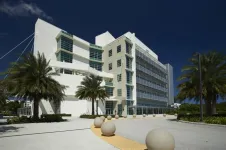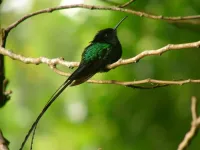(Press-News.org) Researchers at Pitt have produced the most detailed image to date of a bacteriophage–phage for short–that has allowed them to see for the first time the structural makeup of the part of the phage that directly attaches to its target Mycobacterium cell.
“Now you've got like a spec sheet for going in and designing phages so that they’ll bind to different kinds of cells,” said Graham Hatfull, the Eberly Family Professor of Biotechnology in the Kenneth P. Dietrich School of Arts and Sciences.
That’s important because of what a phage, which is a kind of virus, does after it binds to a bacterial cell: it pierces a hole in the cell membrane and injects its own DNA turning the bacteria into a phage factory.
With antibiotic resistance on the rise, in some cases phages are the only option to fight off bacterial infections. They are, however, picky assassins; a particular kind of phage will typically attack just one strain of bacteria. The ability to engineer a phage to seek out and destroy a specific bacteria could be a medical game-changer.
The research was published in the journal Cell.
There are about 1031 phages on the planet–about one trillion for every grain of sand–and they have been evolving for billions of years. Despite all the variation this long history has given rise to, they almost all share similar components: a capsid, a tail tube, and a tail tip.
A phage capsid sits like a head atop the narrow tail tube. Researchers have been able to capture high-resolution imagery of phage capsids for a while now for a couple of reasons.
“First, it’s gigantic and easy to find,” said Krista Freeman, a research associate in Hatfull’s lab. But the capsid has another advantage when it comes to cryo-electron microscopy, or cryo-EM, one of two imaging techniques used in this work. The capsid is comprised of 60 symmetrical parts that can be averaged together to boost the signal. Imaging a phage using cryo-EM actually entails stitching together a lot of images from different angles. Because of the symmetry, relatively few images are needed to assemble enough information to piece together an entire capsid.
The rest of the phage’s body is quite small by comparison, and less symmetric.
“So you have to be more careful,” Freeman said. “You have to find more particles, and do more hunting, and do more manual manipulations. It's much less automated than getting the big structure.”
Phages are bundles of tangled, intertwined proteins that loop around and through the structure. They are less like a globe, with its information painted on the surface, and more like a sculpture of a flower–constructed out of Slinkies.In practice, this means it requires taking tens of thousands of images of phages, all oriented in different ways, to piece together a complete image.
With this massive amount of data, and a massive amount of computing power, Freeman was able to recreate the tail tube and, perhaps most tantalizingly, the tip of the tail, which binds to the bacteria. Currently, researchers do not know why a particular phage attacks a particular strain of bacteria. “The tip of the tail, that’s the part that’s recognizing the bacteria cell,” Hatfull said. “We’re especially interested in it for this reason.”
Their high-definition images have allowed them to see structures that had previously only been resolved to a fuzzy grayscale, indicative of the density of electrons.
“Now you can show every molecular component in this thing,” Freeman said. “And it’s just breathtaking.” It’s also revealing structural information that researchers can explore to better understand the point of contact between a phage and its bacterial target.
“It was astonishing to find out how complex the tail tip structure is,” she said. “It's an intricate assembly of 10 distinct proteins. There are countless intimate interactions between these that enable the overall structure to do the complicated job of finding, binding to, and infecting the bacterial host.”
The images are made dynamic thanks to work done by Raphael Park and his colleagues at Scripps Research who used another kind of imaging, cryo-electron tomography (cryo-ET), which images phages bound to the bacterial cell, highlighting the entire phage and where it attaches to the bacterial cell surface.
In some images, the phage’s DNA is plainly visible inside the capsid, in others, it has made its way through the cell wall of the bacteria. Between these two steps, “there are some subtle differences,” in the structure of the phage Hatfull said. These may point to the mechanism by which the DNA is triggered to leave the capsid, or how it is transported through the tail tube.
“These are new insights,” Hatfull said. “There are a lot of questions remaining.” But Hatfull, Freeman, and researchers across the world can now start thinking seriously about beginning to engineer phages to recognize different bacteria.
“Before, we wouldn’t have stood a chance. And now, doing this is going to become completely routine.”
Research reported in this publication was supported by the National Institute Of General Medical Sciences of the National Institutes of Health under Award R35GM131729 and by the National Institute of Allergy and Infectious Diseases of the National Institutes of Health under Award K99Al173544. The content is solely the responsibility of the authors and does not necessarily represent the official views of the National Institutes of Health.
END
Pitt researchers release Phage images with unprecedented detail
New pictures show molecular-scale components of head, tail tube, tail tip
2025-04-15
ELSE PRESS RELEASES FROM THIS DATE:
Sound wave research for breast cancer receives $5.5 million
2025-04-15
University of Virginia researcher Natasha D. Sheybani, PhD, has received $5.5 million from the federal Department of Defense to support her cutting-edge efforts to use focused sound waves to improve our immune system’s ability to battle breast cancer.
Sheybani, the research director of UVA’s Focused Ultrasound Cancer Immunotherapy Center, was the only scientist in the nation selected to receive a Breast Cancer Research Program Era of Hope Scholar Award in the latest funding round; she is UVA’s first recipient of the award. She will use the grant to advance her research into the potential of focused ultrasound to improve the safety, ...
Gene variant linked to benign prostate hyperplasia risk in Lebanese men
2025-04-15
“Our results indicate a strong association between certain genotypes of the SNP -765 G>C of the PTGS2 gene and BPH.”
BUFFALO, NY – April 15, 2025 – A new research paper was published in Oncotarget, Volume 16, on April 4, 2025, titled “Association between two single nucleotide polymorphisms of the Prostaglandin-Endoperoxide Synthase 1 and 2 genes and cell proliferative prostatic diseases in Lebanon.”
The team of researchers led by first author Brock J. Sheehan and corresponding author Ruhul H. Kuddus, from Utah Valley University, discovered that a specific genetic variation ...
Teoxane announces new study reinforcing the biocompatibility, safety and efficacy of RHA®4 in dynamic facial support
2025-04-15
Teoxane reinforces its commitment to scientific innovation with the publication of a new study in Plastic and Reconstructive Surgery – Global Open, providing robust preclinical and clinical evidence on the safety, biocompatibility, and performance of RHA®4* in midface augmentation.
The study confirms that RHA®4[1], a resilient hyaluronic acid filler designed for dynamic facial areas[2],[3], integrates harmoniously within subcutaneous adipose tissue, preserving its natural biomechanics while delivering effective volume restoration. ...
Study identifies U.S. hotspots for drinking water quality violations and lack of access to safe, clean water
2025-04-15
Herndon, VA, March 25, 2025 -- About two million people in the United States lack access to running water or indoor plumbing in their homes. Another 30 million people live where drinking water systems violate safety rules. Water privatization -- the transfer of public water systems ownership and/or management to private companies -- has been proposed as a potential solution to provide more Americans with safe, clean drinking water. But opponents argue that private companies may prioritize profits over public needs.
To investigate how ...
Busted! Researchers revolutionize fraud detection with machine learning
2025-04-15
Fraud is widespread in the United States and increasingly driven by technology. For example, 93% of credit card fraud now involves remote account access, not physical theft. In 2023, fraud losses surpassed $10 billion for the first time. The financial toll is staggering: credit card fraud costs $5 billion annually, affecting 60% of U.S. cardholders, while identity theft resulted in $16.4 billion in losses in 2021. Medicare fraud costs $60 billion each year, and government losses range from $233 billion to $521 billion annually, with improper payments totaling $2.7 trillion since 2003.
Machine learning plays a critical ...
Earthworm-inspired multimodal pneumatic continuous soft robot enhanced by winding transmission
2025-04-15
A research paper by scientists at Tianjin University presented an earthworm-inspired multimodal pneumatic continuous soft robot enhanced by wire-winding transmission.
The research paper, published on Mar. 19, 2025 in the journal Cyborg and Bionic Systems, proposes an earthworm-inspired multimodal pneumatic continuous soft robot to simultaneously achieve multimodal motion and good motion performance. Using the derived overlapped continuous control law (DOCCL) and wire-winding transmission, the robot can achieve a maximum planar crawling speed that surpasses that of other robots of the same type by an order of magnitude.
With ...
Coastal heritage threatened by climate change
2025-04-15
Humans have always lived by coasts and waterways, and thus these locations are rich with archeological sites. Natural and cultural resource management are conducted separately, despite the fact that climate change, sea level rise, and extreme weather threaten them both. Jayur Mehta and colleagues argue a synergy of both approaches is required to protect coastal archaeological landscapes. The authors used LiDAR digital elevation models, site location data, and NOAA sea level rise models to define ...
A tale of two hummingbird bills
2025-04-15
There are two species of streamertail hummingbirds on the island of Jamaica, West Indies—one with red-billed males (Trochilus polytmus) and the other with black-billed males (T. scitulus). This is a puzzling situation, as many evolutionary biologists have argued that avian speciation is unlikely to occur on small oceanic islands. Caroline Duffie Judy and colleagues investigated the hybrid zone that separates the two species, which is as narrow as 3.2 km. The authors analyzed 186 Trochilus specimens from 12 ...
Corn leads to improved performance in lithium-sulfur batteries
2025-04-15
PULLMAN, Wash. -- Researchers at Washington State University have demonstrated a way to use corn protein to improve the performance of lithium-sulfur batteries, a finding that holds promise for expanding the use of the high-energy, lighter-weight batteries in electric vehicles, renewable energy storage and other applications.
Lithium-sulfur batteries are lighter for the same amount of energy and more environmentally friendly than commonly used lithium-ion batteries, but their commercial adoption has been limited by technological hurdles that shorten their lifespan.
The WSU team’s research, published in the Journal of Power Sources, ...
SynGAP Research Fund (SRF), dba Cure SYNGAP1, announces Board of Trustees Update 2025
2025-04-15
Mill Valley, CA – April 15, 2025 – SynGAP Research Fund (SRF), dba Cure SYNGAP1, the leading patient advocacy group dedicated to improving the lives of those affected by SYNGAP1-related disorders (SRD), today announced the appointment of Jaime Aranda, Steve Gore, Heather Mestemaker, and Brian Smith to its Board of Trustees, effective April 15, 2025. They will succeed outgoing Trustees Emily Barnes, Sydney Stelmaszek, and Stella Tavilla, whose terms conclude on April 14, 2025. Additionally, a seat previously held by Pavel Gerovich, who stepped ...
LAST 30 PRESS RELEASES:
Collaborative study uncovers unknown causes of blindness
Inflammatory immune cells predict survival, relapse in multiple myeloma
New test shows which antibiotics actually work
Most Alzheimer’s cases linked to variants in a single gene
Finding the genome's blind spot
The secret room a giant virus creates inside its host amoeba
World’s vast plant knowledge not being fully exploited to tackle biodiversity and climate challenges, warn researchers
New study explains the link between long-term diabetes and vascular damage
Ocean temperatures reached another record high in 2025
Dynamically reconfigurable topological routing in nonlinear photonic systems
Crystallographic engineering enables fast low‑temperature ion transport of TiNb2O7 for cold‑region lithium‑ion batteries
Ultrafast sulfur redox dynamics enabled by a PPy@N‑TiO2 Z‑scheme heterojunction photoelectrode for photo‑assisted lithium–sulfur batteries
Optimized biochar use could cut China’s cropland nitrous oxide emissions by up to half
Neural progesterone receptors link ovulation and sexual receptivity in medaka
A new Japanese study investigates how tariff policies influence long-run economic growth
Mental trauma succeeds 1 in 7 dog related injuries, claims data suggest
Breastfeeding may lower mums’ later life depression/anxiety risks for up to 10 years after pregnancy
Study finds more than a quarter of adults worldwide could benefit from GLP-1 medications for weight loss
Hobbies don’t just improve personal lives, they can boost workplace creativity too
Study shows federal safety metric inappropriately penalizes hospitals for lifesaving stroke procedures
Improving sleep isn’t enough: researchers highlight daytime function as key to assessing insomnia treatments
Rice Brain Institute awards first seed grants to jump-start collaborative brain health research
Personalizing cancer treatments significantly improve outcome success
UW researchers analyzed which anthologized writers and books get checked out the most from Seattle Public Library
Study finds food waste compost less effective than potting mix alone
UCLA receives $7.3 million for wide-ranging cannabis research
Why this little-known birth control option deserves more attention
Johns Hopkins-led team creates first map of nerve circuitry in bone, identifies key signals for bone repair
UC Irvine astronomers spot largest known stream of super-heated gas in the universe
Research shows how immune system reacts to pig kidney transplants in living patients
[Press-News.org] Pitt researchers release Phage images with unprecedented detailNew pictures show molecular-scale components of head, tail tube, tail tip








